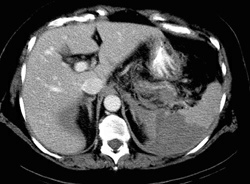
RADIOLOGY: SPLEEN: Case# 53: SPLENIC INFARCT; INTRAPERITONEAL HEMORRHAGE. 51 year old female with probable right renal infarct discovered on outside abdominal CT. Abdominal arteriogram performed at that institution reportedly revealed " diffuse fibromuscular dysplasia" but that diagnosis was not confirmed by review of the films. Patient has worsening abdominal pain. There is a large, wedged shaped area of low attenuation in the spleen, consistent with infarct. Perisplenic fluid is present, at least some of which appears external to the splenic capsule. Fluid is seen in the left anterior perirenal space, abutting the tail of the spleen. No abnormality is seen in fat surrounding the pancreatic tail laterally and anteriorly. The splenic and portal veins appear patent. There is a wedged shaped area of low attenuation in the right kidney, consistent with infarction; however, smaller areas within this geographic perfusion defect show minimal enhancement. The left kidney is within normal limits. A small amount of fluid is present around the inferior tip of the liver and tracts inferiorly in the right paracolic gutter. The various etiologies of splenic infarct include embolism, local thrombosis, vasculitis, vascular compromise of splenic artery (such as pancreatitis or splenic artery aneurysm), and therapeutic/procedural complication. The CT phases of splenic infarction include: (1) Hyperacute (day 1) -- mottled area of increased attenuation due to hemorrhage (2) Acute (day 2-4) subacute (day 4-8) -- progressive delineation of area of decreasing attenuation (3) Chronic (week 2-4) -- attenuation returns to normal; may have calcification Splenic infarction may be complicated by splenic rupture and hemorrhage, as in this case.